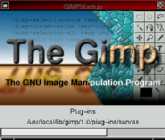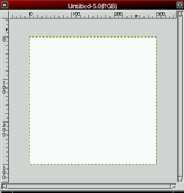Reasons to choose GIMP...
|

|
A cool start up banner!
|
|
Every day a new tip...
|
 |
|

|
A simple, powerful, and adjustable toolbar...
|
|
A drawing area with pan, zoom, rotate, scale,
resize and more!
|
 |
Click on the links below for more pictures!
|
Name |
Shows |
|
prefs.jpg |
Configuration panel for GIMP,
display, memory useage, file and path settings, transparency etc. |
|
brushes.jpg |
Allows the selection of a brush
shape to use when drawing/painting. |
|
patterns.jpg |
The default pattern to use as
a fill etc. |
|
grads.jpg |
Create a user defined gradient
for use when you need, or use an exitisting 'custom' one. |
|
palette.jpg |
Shows the range of colours used
by GIMP and your image/s. |
|
toolopt1.jpg
toolopt2.jpg |
Shows the use of the 'ToolOption'
dialogue box. The contents of the box changes automatically, and dynamically
as you change between tools. |
|
script1.jpg
script2.jpg |
Shows how powerful GIMP can
be, the power of the scripts and plug-ins truly is cool! and fun:)
This shows how a script works - you choose the script
from the pulldown menu (this is NEON) and customise it, and press OK! |
|
filter1.jpg |
Similar to scripts, filters
are just as useful, this is an example of a lens-flare filter plug-in.
It is called GFlare. This one's really CPU intensive - my Cyrix starts
to cry ;) |
|
Linux had been lacking a major graphics creation
tool for quite a while until gimp was released.
gimp has most of the features of many commercial products on platforms
such as Mac-OS and Win95.
Layers, transparency and other effects are all handled with ease. Huge
image sizes are supported - upto 4000x4000 I believe - along with plugins,
scripts, gradients, tints, the lot....
If you can think of something you want to do with an image, gimp can
probably do it :) Many people have contributed plug-ins to use with gimp;
every single graphics file type (and a few non-graphic ones too!)
must be supported by now, and thats no exageration!
There is a wide range of filters, distorts and plug-ins that provide
additional functionality to gimp. But take care, it is easy to get excited
and add every single plug-in that you can find. I went crazy and have ended
up with 168 (so far) 'compressed' plug-ins in my /usr/local/lib/gimp/1.0/plug-ins
directory, I know it's over the top, but I keep thinking to myself; "I
might need to use one of them one day.."
As a result, and with a huge set of extra gradients, brushes, and patterns,
the total amount of memory that gimp takes up is around 70Mb - though about
15-20Mb of that is the undo buffer. If I load StarOffice at the same time,
thats about 135Mb of memory over and above that needed by X and Linux.
I already have 88Mb and a 150Mb swap partition, but thats a grotesquely
huge amount!!!!
Don't get the idea that you need extreme amounts of memory to run it
though. You can get it to use around 10Mb of memory if you prune your plug-ins
directory carefully, and don't go crazy with brushes, gradients, and patterns.
You can probably do with a 500k or 1Mb undo buffer to (though that's pushing
it:)
A sensible minimum (x86) spec for running Gimp would go something like
this:
-
Fast 486dx2/dx4 (co-pro desperately needed)
-
20Mb memory (preferably more eg. 32Mb+) - you may scrape through on just
16Mb...
-
8bit colour upwards - though 16bit will get you far better results and
enjoyment.
As I stated on my index page, all of the images used in these web pages
were created with gimp. It really is a versatile program.
I belive that there is even a scanning plug-in for it; which is a rare
thing indeed with Linux, and unix in general.
|

